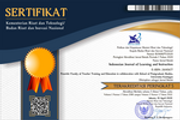THE IMPLEMENTATION OF SCIENCE TECHNOLOGY ENGINEERING AND MATHEMATICS (STEM) 5E TO OMPROVE STUDENTS’ CREATIVITY AND PROBLEM-SOLVING SKILLS IN LEARNING THE HUMAN CIRCULATORY SYSTEM
Abstract
This research was motivated by the low creativity of students and problem solving skills, only 10% showed indicators of creativity. The purpose of this research is to increase students' creativity and problem solving skills through the implementation of STEM 5E. Creativity and problem solving skills are important for students as provisions in the future. The population in this study were Middle School students. 8 at SMPN 1 Jalaksana, which is divided into two classes, namely the experimental class and the control class. The research design used is a nonequivalent control group design, the type of research is quasi-experimental. The experimental class uses STEM 5E learning, while the control class uses demonstration learning. The instruments used in this study were observation sheets, written tests of 15 description questions with three indicators of problem-solving ability, namely recognizing problems, finding problems, and provide solutions, and other data in the form of a questionnaire to determine student responses. The results of the study on the implementation of STEM 5E learning showed that the preliminary, core and closing activities were carried out well. The results of observations of student creativity showed that the average value of the experimental class was 71.58 while the control class was 28.97. The average result of the experimental class students' problem solving ability was 81.11, much higher than the control class at 40.79. With the implementation of STEM 5E experimental class students are better in terms of creativity and problem solving skills.
Keywords: STEM 5E; creativity; ability to solve problems.
Full Text:
PDFReferences
Casing, P. I., and Romble, D. B. (2021). Students’ mathematical creative thinking ability with Posing-Exploring-Doing-Evaluating (PEDE) productive failure model in new normal. American Journal of Educational Research, 9(7), 443-448. doi: 10.12691/education-9-7-8.
Chayati, N., Masykuri, M., & Utomo, S. B. (2020). Development learning cycle 5e module integrated with science, technology, engineering, and mathematics (stem) in thermochemistry. Jurnal Kimia dan Pendidikan Kimia, 5(3), 282-292.
Cho, H., Pemberton, C. L., & Ray, B. (2017). An exploration of the existence, value and importance of creativity education. Current Issues in Education, 20(1).
Djamarah, S. B., & Zain, A. (2010). Strategi Belajar Mengajar. Jakarta: Rineka Cipta.
Gardner, H. (1993). Multiple Intelligences: The Theory in Practice. New York: Basic book.
Hill, K. N. (2019). Science, Technology, Engineering And Mathematics (STEM): ITS INFLUENCE On Student Performance In Core Content Areas. Jefferson City USA: Carson-Newman University.
Mardhiyatirahmah, L. (2019). Dampak penerapan pendekatan STEM pada pembelajaran Matematika di sekolah. In Senandika
Munandar, U. (2004). Pengembangan Kreativitas Anak Berbakat. Jakarta: Rineka Cipta.
Nugroho, O. F., Permanasari, & Firman, H. (2019). The movement of stem education in indonesia: science teachers’ perspectives. Jurnal Pendidikan IPA Indonesia, 8(3), 417-425.
Pradeep, D. M. (2015). Teaching STEM effectively with the learning cycle approach. Center for Science Teaching and Learning NorthernvArizona University, 1(1), 5-12.
Siswanto, J. (2018). Keefektifan Pembelajaran Fisika dengan Pendekatan STEM untuk Meningkatkan Kreativitas Mahasiswa. Jurnal Penelitian Pembelajaran Fisika , 133-137.
Suciati. (2018). Pengembangan kreativitas inovatif melalui pembelajaran digital. Jurnal Pendidikan, 19(2).
Sugiyono. (2018). Metode Penelitian Kuantitatif, Kualitatif dan R&D. Bandung: Alfabeta.
Sugiyono., (2019). Metode Penelitian Pendidikan. Bandung: Alfabeta.
Tan, S. (2020). Assessing Creative Problem Solving Ability in Mathematics: Revising the Scoring System of the DISCOVER Mathematics Assessment. The University of Arizona.
Usman, B. (2002). Media Pendidikan. Jakarta: Ciputata Press.
Wicaksono, A. G. (2020). Penyelenggaraan Pembelajaran IPA berbasis Pendekatan STEM dalam menyongsong era revolusi industri 4.0. Lensa (Lentera Sains) : Jurnal Pendidikan IPA Vol. 10 (1), 54-62.
Wiguna, B. J. P. K., Suwarma, I. R., &Liliawati, W. (2018). STEM-based science learning implementation to identify student’s personal intelligences profiles. Journal of Physics: Conference Series, 1013(1), IOP Publishing
Wiryawan, S. A. (1987). Strategi Belajar Mengajar. Jakarta: Karunia Universitas Terbuka.
Yamtinah, S., Masykuri, M., Ashadi, and Shidiq, A. S. (2017). An analysis of students’ science process skills in hydrolysis subject matter using testlet instrument. ICTTE, 158, pp. 101–110.
DOI: https://doi.org/10.25134/ijli.v5i1.5871
Refbacks
- There are currently no refbacks.
Copyright (c) 2022 Indonesian Journal of Learning and Instruction

This work is licensed under a Creative Commons Attribution-NonCommercial-ShareAlike 4.0 International License.

